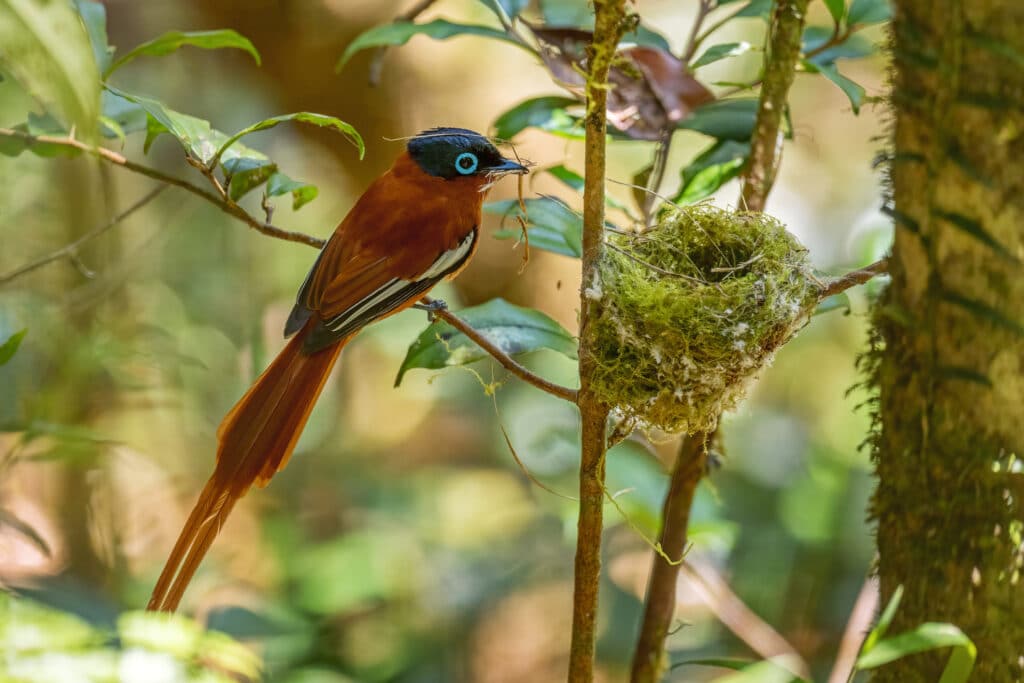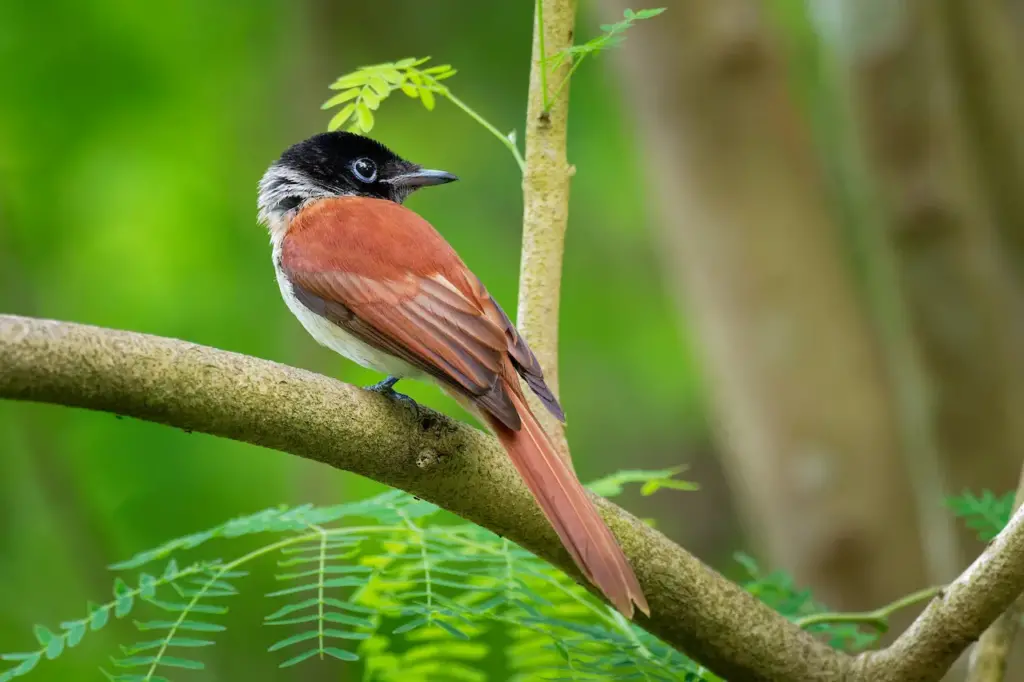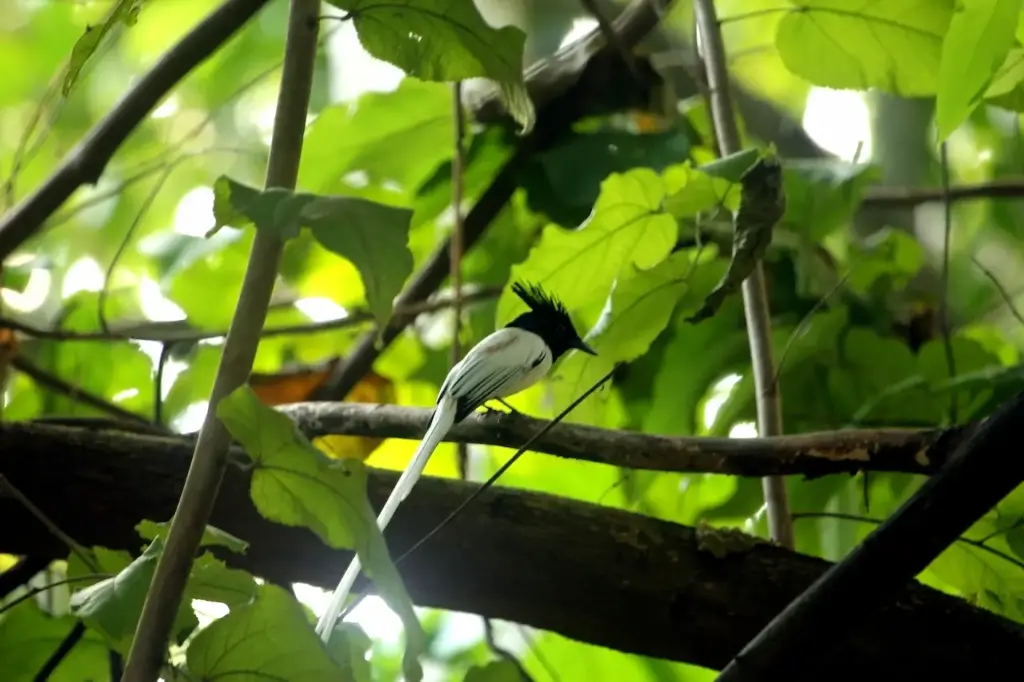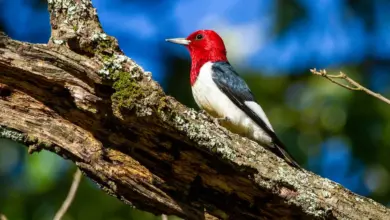Paradise Flycatchers
Tersiphone: Paradise Flycatchers
The paradise flycatchers, Terpsiphone, are a genus of monarch flycatchers. The genus ranges across Africa and Asia, as well as several islands. A few species are migratory, but the majority are resident.
The most telling characteristic of the genus is the long tail streamers of the males of many species.
In addition to the long tails the males and females are sexually dimorphic and have rufous, black and white plumage.

Distribution, habitat, and movements
The paradise flycatchers have the widest distribution of any of the monarch flycatchers, ranging across sub-Saharan Africa, southern and eastern Asia, and down into Southeastern Asia. At the northern extreme of its range, it reaches Korea and Afghanistan.
The species also occurs on several islands, including those of Indonesia and the Philippines, Taiwan, and Japan, as well as Madagascar, the Mascarenes, and the Seychelles in the Indian Ocean and Sao Tome off Africa’s Atlantic coast.
The paradise flycatchers inhabit a range of habitat types, from rainforests to montane forests, woodlands, savannas, mangroves, riparian forests, deciduous forests, and bamboo groves, Some species will also move into gardens and cultivated habitats.
Several species of paradise-flycatcher are migratory. The Japanese Paradise-flycatcher is almost entirely migratory, breeding in Korea and Japan and wintering in the Philippines, Malaysia, and Sumatra. It does however also occur in Taiwan, where the population is resident.
The Asian Paradise-flycatcher is migratory in the northern parts of its range, breeding as far north as Afghanistan, northern China, and Korea, but all populations north of southern China move south during the winter.
The movements of the other species are not fully understood, but most are thought to be resident. Several subspecies of the African Paradise-flycatcher are intra-African migrants, but little is known about these movements.
Description
The paradise flycatchers are generally small birds, around 18–1 cm in length and weighing 12–23 g. They have a medium-length grey or blueish bill which is broad and hooked at the end and is surrounded by stiff rictal bristles.
The inside of the mouths of paradise flycatchers are brightly coloured, being either yellow or green.

The tails are long, particularly in many species where the male has a massively elongated pair of middle tail feathers. These tail streamers are 195 mm long in the male Sao Tome Paradise flycatcher and 412 mm long in the male Asian Paradise flycatcher. The function of the long tail is assumed to be related to sexual selection, with females choosing males based on the length of the tail. Not all species have long tail streamers, for example, the Blue Paradise flycatcher of Palawan in Asia and the Bedford’s Paradise flycatcher of Montane Africa do not have exceptionally long tails.
In most species, the tail is longer than the wing, even in the shorter-tailed females. The eye is surrounded by an eyering that is a blue-thin wattle (slightly more pronounced in some species like the Rufous Paradise Flycatcher).
The plumage of the paradise flycatchers is sexually dimorphic, with rufous, white, and black being the most common colours; one species has blue plumage and a few have traces of maroon. Sexual dimorphism (visual physical differences between the sexes) can be pronounced (and, of course, more so in the long-tailed males) or subtle; the female Bedford’s Paradise-flycatcher is identical to the male except slightly duller.
Some species sport prominent crests. In some species, for example, the Madagascar Paradise-flycatcher, the males have two or more colour morphs.
Calls and song
The paradise flycatchers make a range of vocalisations, ranging from whistling songs to harsher calls. These songs and calls are typical of the monarch flycatchers. The songs are simpler in the Asian species, for example, the call of the Japanese Paradise-flycatcher is a repeated three-syllable whistle. The songs of the African species are more complex and, in the case of species with a large range, vary geographically. The calls are generally simple and are harsh and grating.
Diet and feeding
The paradise flycatchers are, as their name suggests, insectivores, feeding on a variety of insects, usually obtained on the wing. They use a variety of foraging techniques, including hawking from a perch, sallying hovering, gleaning, and flush-pursuiting. They will join mixed-species feeding flocks, for example, the Madagascar Paradise-flycatcher will regularly form small two-species flocks with the Common Newtonia while foraging.
Breeding
Paradise flycatchers, like all monarch flycatchers, are monogamous and are generally territorial, although in some cases birds may nest close together and defend the nests together against predators. Females select males based on their tail length, a form of sexual selection. Paradise flycatchers are unusual as exaggerated sexual traits are usually found in promiscuous birds, not monogamous ones. The nests of this genus are neat deep cups placed on a branch or twig, often in a fork. They are usually placed 1-3 m off the ground. They are often very conspicuous, particularly when the long-tailed males are incubating. The nests are, however, aggressively defended by the pair. Amongst the pair, duties are shared but not equally. For example, in the Madagascar Paradise-flycatcher, the female undertakes more brooding responsibilities whereas the male spends more time guarding the nest.

Species
- Terpsiphone atrocaudata (Eyton, 1839) – Japanese Paradise Flycatcher
- Terpsiphone atrochalybeia (Thomson, 1842) – Sao Tome Paradise Flycatcher
- Terpsiphone latest Chapin, 1921 – Bate´s Paradise Flycatcher
- Terpsiphone bedfordi (Ogilvie-Grant, 1907) – Bedford’s Paradise Flycatcher
- Terpsiphone bourbonnensis (Statius Müller, 1776) – Mascarene Paradise Flycatcher
- Terpsiphone cinnamomea (Sharpe, 1877) – Rufous Paradise Flycatcher
- Terpsiphone corvina (Newton, E, 1867) – Seychelles Paradise Flycatcher
- Terpsiphone cyanescens (Sharpe, 1877) – Blue Paradise Flycatcher
- Terpsiphone mutata (Linnaeus, 1766) – Madagascar Paradise Flycatcher
- Terpsiphone paradisi (Linnaeus, 1758) – Asian Paradise Flycatcher
- Terpsiphone rufiventer (Swainson, 1837) – Red-bellied Paradise Flycatcher
- Terpsiphone rufocinerea (Cabanis, 1875) – Rufous-vented Paradise Flycatcher
- Terpsiphone smithii (Fraser, 1843) – Annobón Paradise flycatcher
- Terpsiphone viridis (Statius Müller, 1776) – African Paradise Flycatcher




